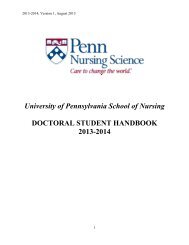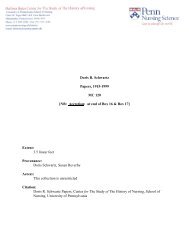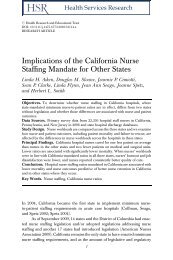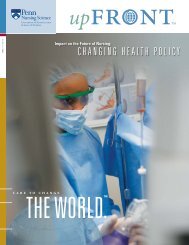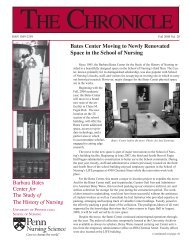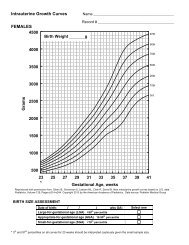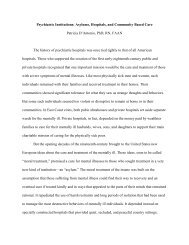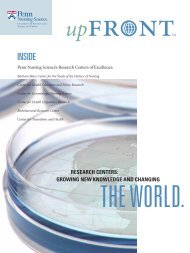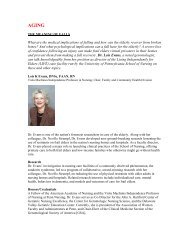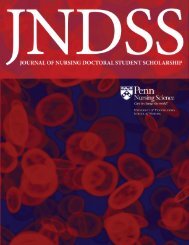Penn Nursing 090805_final_4c - University of Pennsylvania School ...
Penn Nursing 090805_final_4c - University of Pennsylvania School ...
Penn Nursing 090805_final_4c - University of Pennsylvania School ...
You also want an ePaper? Increase the reach of your titles
YUMPU automatically turns print PDFs into web optimized ePapers that Google loves.
An Epidemic <strong>of</strong> Autism?<br />
Jennifer A. Pinto-Martin<br />
PhD, MPH<br />
Pr<strong>of</strong>essor <strong>of</strong> <strong>Nursing</strong><br />
Anyone reading a newspaper or following<br />
media reports has probably<br />
heard about the skyrocketing rates <strong>of</strong><br />
autism being identified. Earlier this<br />
year, NBC News ran a series called<br />
“Autism:The Hidden Epidemic?” with<br />
reports on the Nightly News as well as<br />
on Today. Meanwhile, The New York<br />
Times and other newspapers reported<br />
on the increased prevalence <strong>of</strong> autism<br />
and the purported link between autism<br />
and common childhood vaccines containing<br />
mercury.<br />
But is there, in fact, an epidemic <strong>of</strong><br />
autism? Scientists are asking that question<br />
and Jennifer Pinto-Martin, PhD,<br />
MPH, Pr<strong>of</strong>essor <strong>of</strong> <strong>Nursing</strong>, thinks not.<br />
To support her position, she is working<br />
with a multidisciplinary group <strong>of</strong> investigators<br />
at <strong>Penn</strong>, and throughout the<br />
nation, to study the prevalence and<br />
causes <strong>of</strong> autism spectrum disorders<br />
(ASDs), as well as to improve early<br />
identification <strong>of</strong> the disorder and the<br />
provision <strong>of</strong> services to those affected.<br />
Dr. Pinto-Martin, who has a joint<br />
appointment in the <strong>School</strong> <strong>of</strong><br />
Medicine’s Department <strong>of</strong><br />
Epidemiology and Biostatistics, is the<br />
principal investigator and Director <strong>of</strong><br />
<strong>Penn</strong>’s Center for Autism and<br />
Developmental Disabilities Research<br />
and Epidemiology (CADDRE), one<br />
<strong>of</strong> six centers funded nationwide by<br />
the Centers for Disease Control<br />
(CDC).An epidemiologist by training,<br />
Dr. Pinto-Martin agrees that the<br />
prevalence <strong>of</strong> autism is greater today<br />
than it was 20 years ago:“The question<br />
is, is that really an increase in the<br />
actual risk <strong>of</strong> the disease or is it just an<br />
increase in our ability to identify it?<br />
Most <strong>of</strong> us working in the field<br />
believe it’s the latter.”<br />
The CADDRE centers, along<br />
with the 16-site Autism and<br />
Developmental Disabilities Monitoring<br />
Network (ADDM), are conducting a<br />
surveillance study to determine the<br />
actual incidence <strong>of</strong> autism spectrum<br />
disorders in the United States.The<br />
strength <strong>of</strong> this study, according to<br />
developmental pediatrician Susan Levy,<br />
MD, Medical Director <strong>of</strong> the Regional<br />
Autism Center at The Children’s<br />
Hospital <strong>of</strong> Philadelphia (CHOP), is<br />
that the centers are all using the same<br />
rigorous methodology for determining<br />
whether a child does, in fact, meet the<br />
criteria for autism.<br />
The methodology involves a<br />
detailed abstracting <strong>of</strong> clinical records,<br />
where specially-trained abstractors<br />
identify certain words and phrases in<br />
each record and transfer the information<br />
to a special format, which is then<br />
reviewed by an expert clinician.The<br />
clinicians then use a special protocol to<br />
determine whether the abstracted<br />
items fit the diagnostic criteria established<br />
in the DSM-IV (Diagnostic and<br />
Statistical Manual <strong>of</strong> Mental Disorders<br />
– fourth edition), the bible <strong>of</strong> psychiatric<br />
diagnoses.<br />
The process is painstaking, says Dr.<br />
Levy, but it has given her a better<br />
understanding <strong>of</strong> the roots <strong>of</strong> the<br />
DSM-IV criteria. Many clinicians rely<br />
so much on their clinical judgment,<br />
developed over years <strong>of</strong> seeing patients,<br />
that they reject more systematic tools<br />
like this, says Dr. Levy. But clinical<br />
judgment is not exportable and cannot<br />
be compared across clinicians and clinical<br />
settings for research purposes.This<br />
methodology, implemented at all 22<br />
research sites, will provide a measure <strong>of</strong><br />
the prevalence <strong>of</strong> autism across the<br />
nation at the present time, and then<br />
will be repeated in five years to see<br />
whether the prevalence is on the rise.<br />
Although they have different perspectives<br />
from different disciplines, Drs.<br />
Levy and Pinto-Martin agree that they<br />
would like to see similar methodology<br />
applied to adults, because “if the prevalence<br />
in adults is the same, then there’s<br />
no epidemic,” says Dr. Levy.<br />
David Mandell, ScD, a child psychiatric<br />
epidemiologist and health services<br />
researcher at the <strong>University</strong> <strong>of</strong><br />
<strong>Penn</strong>sylvania’s Center for Mental<br />
Health Policy and Services Research<br />
(CMHPSR) brings another perspective<br />
(continued on next page)<br />
Dr. Pinto-Martin and her team meet in <strong>Penn</strong> <strong>Nursing</strong>’s glass-walled conference room at the Center for <strong>Nursing</strong> Research.<br />
13





